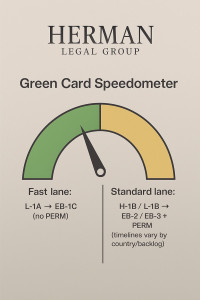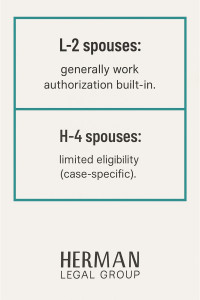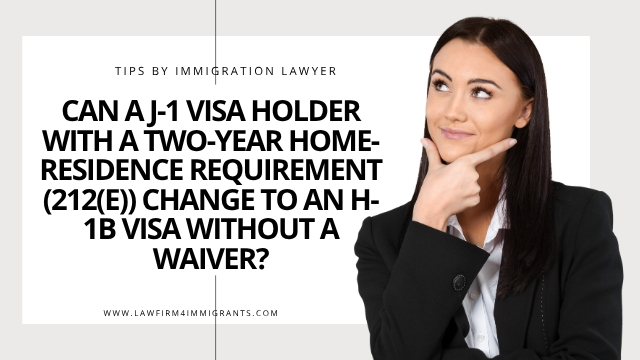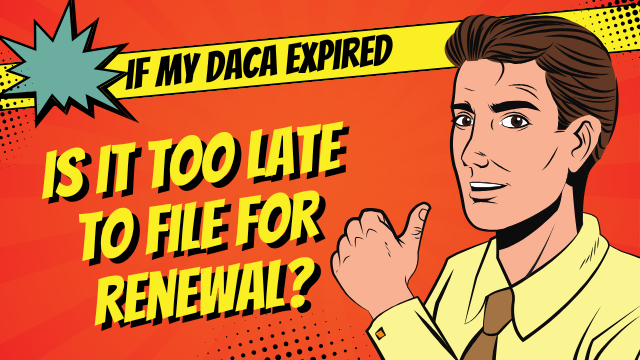This guide explains the real-world differences, advantages, and tradeoffs between the L-1 intracompany transferee visa and the H-1B specialty occupation visa.
What is the H-1B visa in one sentence?
A U.S. employer sponsors a professional for a job that normally requires at least a bachelor’s degree (a “specialty occupation”) and must meet wage and LCA rules, with most cases subject to an annual cap/lottery.
Learn more at USCIS H-1B (specialty occupations): uscis.gov
What is the L-1 visa in one sentence?
A multinational transfers an employee from a foreign affiliate to a U.S. entity to work as a manager/executive (L-1A) or in specialized knowledge (L-1B)—no annual cap/lottery.
See USCIS L-1A (executive/manager): uscis.gov
See USCIS L-1B (specialized knowledge): uscis.gov
Why do employers choose H-1B vs. L-1? (Purpose & Fit)
-
H-1B = hiring talent from anywhere for a U.S. role that requires a degree (or equivalent). Great when the employer doesn’t have a foreign affiliate employing the person.
• USCIS overview: uscis.gov
• Petition form used: Form I-129 (employer-filed): uscis.gov -
L-1 = transferring insiders (already employed abroad by the related company) to a qualifying U.S. entity. Best for multinationals that need leadership or specialized know-how in the U.S.
• Qualifying relationship basics (Policy Manual): uscis.gov
• One year abroad requirement (Policy Manual): uscis.gov
What are the core eligibility differences?
H-1B (Specialty Occupation)
-
Job normally requires a bachelor’s degree or higher (or equivalent).
-
Worker has that degree/major (or equivalent).
-
Employer files an LCA and pays at least the prevailing wage.
• DOL H-1B program & LCA: dol.gov
• Prevailing wage concepts (DOL): dol.gov
L-1 (Intra-company Transferee)
-
U.S. and foreign entities have a qualifying relationship.
-
Employee worked one continuous year abroad within the last 3 years for that related entity.
-
Role in the U.S. is executive/managerial (L-1A) or specialized knowledge (L-1B).
• USCIS L-1A: uscis.gov
• USCIS L-1B: uscis.gov
How long can you stay? (Maximum Periods of Stay)
-
H-1B: usually up to 6 years in total (often 3 + 3), with possible extensions in limited situations if green card steps are underway.
• USCIS temporary workers overview: uscis.gov -
L-1A: up to 7 years total.
-
L-1B: up to 5 years total.
• USCIS L-1 pages: uscis.gov L-1A | uscis.gov L-1B
Is there an annual cap or lottery?
-
H-1B: Yes. Most employers are cap-subject (65,000 + 20,000 advanced-degree exemption). Demand routinely exceeds supply → lottery selection.
• DOL H-1B program page: dol.gov -
L-1: No annual cap/lottery for the vast majority of cases.
Do wage rules apply? (LCA & Prevailing Wage)
-
H-1B: Yes. Employer must file an LCA with the DOL and pay at least the prevailing wage for the role/location.
• DOL H-1B program & LCA: dol.gov -
L-1: No LCA/prevailing wage requirement (but other compliance rules still apply; USCIS can scrutinize job duties, org charts, and relationships).
What about spouses and kids? (Dependents & Work Authorization)
-
H-1B family members enter in H-4 status; H-4 spouses may qualify for employment authorization in limited, specific circumstances (e.g., based on the H-1B principal’s long-term green-card process).
• USCIS temporary workers overview (family): uscis.gov -
L-1 family members enter in L-2 status; L-2 spouses generally have broad work authorization.
How do the green card paths compare?
-
L-1A → EB-1C (Multinational Manager/Executive)
Fastest, no PERM labor certification. Ideal for senior leaders who meet EB-1C criteria. -
L-1B or H-1B → EB-2/EB-3 (PERM-based)
Typical route for most professionals and specialized-knowledge workers; requires PERM labor certification (DOL) and is subject to priority date backlogs.
• DOL permanent labor (PERM) information hub: dol.gov
If you qualify for L-1A, your EB-1C immigrant visa category can significantly reduce total time to permanent residence compared to the PERM route common for H-1B and L-1B.
Side-by-Side: H-1B vs. L-1 (Quick Table)
| Feature | H-1B | L-1A / L-1B |
|---|---|---|
| Core purpose | Hire a professional for a U.S. role needing a degree | Transfer insider from a foreign affiliate to U.S. |
| Annual cap/lottery | Yes (most employers) | No |
| Degree requirement | Yes (normally) | Not required (focus = role + one year abroad) |
| Prevailing wage/LCA | Yes (DOL) | No |
| Max stay | 6 years (typically) | L-1A: 7 years; L-1B: 5 years |
| Family work auth. | H-4 EAD (limited eligibility) | L-2 spouses: work broadly allowed |
| Green-card track | Often EB-2/EB-3 + PERM | L-1A → EB-1C (no PERM) ; L-1B → EB-2/EB-3 + PERM |
| Employer portability | Can change employers (new petition) | Usually must remain with petitioning employer |
(Program references: USCIS H-1B: uscis.gov | USCIS L-1A/L-1B: uscis.gov | DOL LCA/Prevailing wage/PERM: dol.gov)



Which cases are best for H-1B vs. L-1? (Decision Guide)
Choose H-1B when:
-
You’re hiring a professional (not transferring from abroad).
-
The role requires a degree (or equivalent).
-
You may want the flexibility to change employers later (H-1B portability).
-
You understand and accept the cap/lottery risk and LCA compliance.
• USCIS H-1B overview: uscis.gov
• DOL H-1B/LCA: dol.gov
Choose L-1 when:
-
You have a qualifying relationship between foreign and U.S. entities.
-
The employee has one year of prior employment abroad within the last three years.
-
The U.S. role is executive/managerial (L-1A) or specialized knowledge (L-1B).
-
You want to avoid the lottery and (for L-1A) pursue a faster EB-1C green-card path.
• USCIS L-1A/L-1B: uscis.gov
Compliance corner (what agencies care about)
-
USCIS reviews eligibility, relationship proofs (for L-1), job duties, degrees/experience (for H-1B), and bona fides across the board.
• Policy Manual – L-1 qualifying relationship: uscis.gov -
DOL enforces LCA attestations, wage levels, notice/posting, and public access files for H-1B; it also oversees PERM for EB-2/EB-3.
• DOL H-1B program: dol.gov
• DOL foreign labor programs: dol.gov -
AILA is a premier professional association for immigration lawyers; its practice resources and policy tracking can be valuable context for employers and HR.
• AILA home: aila.org
New Problems and Challenges Facing the H-1B Visa in 2025–2026
The H-1B visa program—long a vital route for U.S. employers to hire highly skilled foreign professionals—is now undergoing historic transformation and intensified scrutiny. A wave of new rules, enforcement actions, and cost barriers has dramatically reshaped how employers must approach H-1B filings in 2025 and beyond.
Below are the five biggest challenges defining this new era.
1. The $100,000 H-1B Filing Fee
The administration announced that all new H-1B petitions filed on or after September 21, 2025 would be subject to a $100,000 filing fee. The intent, according to the White House proclamation and DHS guidance, is to “protect U.S. workers” by reducing demand for temporary skilled visas.
Starting late 2025, every “new” H-1B petition could cost employers an additional $100,000—excluding renewals and amendments already in progress.
Who Must Pay
-
Applies to new H-1B petitions filed for beneficiaries outside the U.S. or entering the program for the first time.
-
Extensions or amendments for current H-1B holders are not covered.
-
Implementation and payment logistics will be confirmed by USCIS in forthcoming guidance via the [Federal Register].
Impact:
-
Employers face unprecedented cost burdens, especially small tech firms and startups.
-
Beneficiaries may see sponsorship opportunities decline as companies reassess hiring.
-
Employers with global footprints may pivot toward L-1 intracompany transfers to avoid the fee.
2. Proposed 2026 H-1B Lottery Reform: Weighted Wage-Based Selection
The FY 2026 H-1B registration system (expected to open March 2026) may no longer operate as a random lottery. The Department of Homeland Security has proposed a shift to a wage-weighted system, prioritizing petitions offering higher salaries or requiring more advanced skills.
What That Means:
-
Level IV wage positions (top percentile per [DOL OES wage data]) would rank higher than entry-level Level I wages.
-
The change aims to “reward employers who pay more competitive wages” but could disadvantage startups or research institutions that offer lower salaries.
-
If finalized, the rule will appear in the [Federal Register] before the FY 2026 registration window opens.
Impact:
-
High-wage tech and STEM positions may dominate selection.
-
Entry-level, nonprofit, or public-sector roles may struggle to compete.
-
Employers must carefully audit job descriptions, wage levels, and LCA filings under [DOL guidance] to maintain compliance.
3. Surge in RFEs (Requests for Evidence) and Case Denials
H-1B adjudications in late 2025 are seeing a marked increase in Requests for Evidence (RFEs)—USCIS notices demanding additional proof before approval. Common triggers include:
-
Vague or mismatched specialty occupation definitions;
-
Unclear employer-employee relationship when a worker is placed at a client site;
-
Gaps in wage-level documentation or failure to match the LCA with the petition.
Snippet callout: RFEs are now standard, not rare. Employers must front-load evidence proving control, supervision, and wage justification.
How to Prepare
-
Provide precise job descriptions aligned with a specific occupational code from [DOL’s O*NET] database.
-
Include organizational charts, supervision details, and payroll records.
-
Ensure the LCA matches every physical worksite where the employee will work.
4. Escalation of USCIS Site Inspections
The Fraud Detection and National Security (FDNS) division within USCIS has expanded its worksite inspection program. These unannounced visits verify that H-1B employees actually perform the duties listed in their petitions and that employers maintain control.
Current Focus:
-
Remote and hybrid work arrangements not reflected on LCAs.
-
Third-party or client-site placements with unclear supervision.
-
Repeated short-term worksite transfers without amended petitions.
Employer Obligations:
-
Maintain copies of the petition, LCA, and payroll records at each active worksite.
-
File an amended H-1B petition through [USCIS Form I-129 instructions] if a new work location is added.
-
Train HR and managers on how to respond professionally to FDNS site visits.
5. Greater Restrictions on Third-Party Placement
The third-party placement model, used by many consulting and staffing companies, is now subject to tighter oversight.
New [USCIS policy guidance] clarifies that employers must demonstrate continuous control over H-1B workers, even when assigned to external client projects.
Compliance Requirements
-
Submit detailed statements of work identifying tasks, duration, and supervision.
-
Prove the petitioner—not the client—retains hiring, firing, and evaluation authority.
-
File H-1B amendments whenever a new client or worksite is added.
Impact
-
IT consulting, engineering, and staffing companies face the heaviest compliance burden.
-
Beneficiaries risk status violations if work assignments change without updated filings.
-
USCIS may deny or revoke petitions where third-party control cannot be proven.
Summary: The New H-1B Landscape
| Challenge | What It Means for Employers & Workers |
|---|---|
| $100K filing fee | Sharp cost increase for new petitions; may deter sponsorship |
| Weighted lottery proposal | Higher-wage petitions favored; entry-level odds fall |
| Rising RFEs | Stronger documentation and job specificity required |
| Site inspections | Heightened on-site compliance and FDNS monitoring |
| Third-party restrictions | More amendments, contracts, and control evidence required |
Herman Legal Group’s Perspective
The H-1B visa has always demanded precision and planning—but 2025 marks a turning point.
Between the unprecedented $100,000 fee, potential 2026 lottery overhaul, and the expanding net of RFEs and compliance audits, U.S. employers can no longer rely on routine processing.
As an immigration law firm with more than three decades of experience, the [Herman Legal Group] advises employers to:
-
Begin H-1B strategy six months early to budget for new fees and compliance costs.
-
Evaluate alternative visa pathways such as L-1, O-1, or EB-1C to mitigate uncertainty.
-
Strengthen documentation and control over every placement or remote assignment.
-
Monitor ongoing updates through [USCIS], [Department of Labor], and the [Federal Register] for final rule implementations.
Internal resources (Herman Legal Group)
-
H-1B Visa – Immigration Attorney Service (HLG):
lawfirm4immigrants.com/h1b-visa-immigration-attorney-service/ -
Book a Consultation (HLG):
lawfirm4immigrants.com/book-consultation/ -
Herman Legal Group – Home:
lawfirm4immigrants.com
FAQ — Quick Answers
Q1. Can I change employers on H-1B?
A. Often yes. A new employer must file a new H-1B petition before you start. (USCIS H-1B basics: uscis.gov)
Q2. Can I switch employers on L-1?
A. Generally no—L-1 ties you to the qualifying organization. A “transfer” usually requires a new L-1 with a qualifying related entity. (USCIS L-1A/L-1B: uscis.gov)
Q3. Do all H-1B employers face the lottery?
A. Most are cap-subject, but certain cap-exempt employers exist (e.g., some nonprofits or research entities). See USCIS for details: uscis.gov
Q4. Does L-1 require a degree?
A. No. L-1 eligibility turns on the qualifying relationship, one-year abroad, and executive/managerial or specialized-knowledge role. (USCIS L-1A/L-1B pages: uscis.gov)
Q5. Where do I find official wage and LCA rules for H-1B?
A. DOL H-1B program page (LCA, wage, compliance): dol.gov
Q6. Where can employers/HR track legal updates and practice trends?
A. The American Immigration Lawyers Association (AILA) provides policy updates and practice resources: aila.org
Author Bio / Profile

Richard T. Herman, Esq. is the founder of the Herman Legal Group and co-author of Immigrant, Inc.: Why Immigrant Entrepreneurs Are Driving the New Economy (and How They Will Save the American Worker). He has spent over 30 years helping companies and professionals navigate U.S. immigration law.
• Bio page (HLG): lawfirm4immigrants.com/attorneys/richard-herman/
• Book a consultation (HLG): lawfirm4immigrants.com/book-consultation/
• Firm home (HLG): lawfirm4immigrants.com
Key Takeaways
-
Purpose split: H-1B = hire a degree-level professional into a U.S. role; L-1 = transfer an existing employee from a foreign affiliate into the U.S. entity.
-
Cap & timing: H-1B is cap/lottery-subject (plan early); L-1 has no cap (file on business timeline if eligible).
-
Wage compliance: H-1B requires LCA and prevailing wage (DOL); L-1 has no LCA, but relationship/role scrutiny is high.
-
Family work rights: L-2 spouses generally have broader work authorization than H-4 spouses.
-
Green-card runway: L-1A → EB-1C (often fastest, no PERM). H-1B/L-1B → EB-2/EB-3 + PERM (timelines vary).
-
Who should choose what: Pick H-1B when hiring from the open market for degree-level roles; pick L-1 when intra-company transfer is feasible and you want no lottery and a potential EB-1C path.
Helpful Official & HLG Links (one place)
-
USCIS H-1B overview: uscis.gov
-
USCIS L-1A / L-1B: uscis.gov
-
USCIS Policy Manual (L-1 relationships/qualifications): uscis.gov
-
DOL H-1B (LCA/wage/compliance): dol.gov
-
AILA (professional association for immigration lawyers): aila.org
-
Herman Legal Group — H-1B services: lawfirm4immigrants.com
-
Herman Legal Group — Book a consultation: lawfirm4immigrants.com
-
Herman Legal Group — Richard Herman bio: lawfirm4immigrants.com








